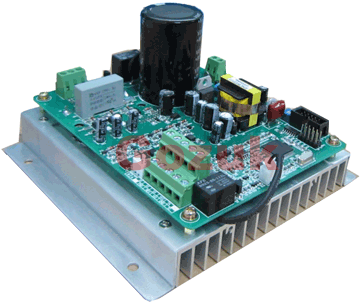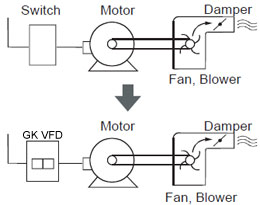Home » Variable Frequency Drives » Page 2
The Gozuk VFD range meets these demands. With components for VFD outputs from 1.5 to 400 kW and line voltages from 220V, 230V, 240V (single phase), 380V, 400V 415V (three phase), the variable frequency drive feature decisive characteristics such as:
- individual travel, lifting, turning and slewing motions by infinitely variable speed control independent of the given load;
- variable torques at constant speed or variable speeds at constant torque;
- VFD acceleration and braking characteristics exactly tailored to meet the needs of the loads to be transported;
- particularly reliable and precise braking characteristics by braking choppers;
- efficient VFD specification, since the rated output may be briefly exceeded when starting against heavy loads;
- precise speed setting by means of switchable inputs;
- multi-motor operation with single variable frequency drive;
- the VFD can be adapted to the specific application by freely programmable inputs / outputs;
- simple and rapid VFD installation by the compact design, also for even more performance;
- already integrated line reactor in the VFD to reduce the need for cabling and wiring, an optional line filter can also be integrated.
Electrical AC motor speed if a fixed value determined by the grid frequency and the number of poles in the stator winding. On principle, you use a Variable Frequency Drive only when you need to adjust the motor speed. This is done by adjusting the VFD output frequency. You can change the frequency (so the speed) from approx 10% to 200%.
There are several applications that can benefit from this variable speed:
There are several applications that can benefit from this variable speed:
- Linear speed sync to compensate speed changes because of mesh issues
- Smooth start & stop of very heavy elements (using delayed speed ramp from 0 to 100% to start and 100% to 0% to stop)
- You can use VFD as motor electrical brake by sudden injection of DC (zero Hz frequency)
- This list can be as long as you can imagine... ...
Featured Articles
Non-Enclosure Variable Frequency Drive ...
 No enclosure (cover), reducing installation space and cost effective. Widely used in All-In-One control cabinet. Keep the same ...
No enclosure (cover), reducing installation space and cost effective. Widely used in All-In-One control cabinet. Keep the same ...
 No enclosure (cover), reducing installation space and cost effective. Widely used in All-In-One control cabinet. Keep the same ...
No enclosure (cover), reducing installation space and cost effective. Widely used in All-In-One control cabinet. Keep the same ...Variable frequency drive application ...
 Variable Frequency Drive (VFD) can be used in lots of fields. Variable frequency drives are widely used to control the speed of ...
Variable Frequency Drive (VFD) can be used in lots of fields. Variable frequency drives are widely used to control the speed of ...
 Variable Frequency Drive (VFD) can be used in lots of fields. Variable frequency drives are widely used to control the speed of ...
Variable Frequency Drive (VFD) can be used in lots of fields. Variable frequency drives are widely used to control the speed of ...Variable frequency drive in HVAC ...
 Variable frequency drives (VFD) have been used for HVAC systems in buildings for more than 40 years. But only in recent years, ...
Variable frequency drives (VFD) have been used for HVAC systems in buildings for more than 40 years. But only in recent years, ...
 Variable frequency drives (VFD) have been used for HVAC systems in buildings for more than 40 years. But only in recent years, ...
Variable frequency drives (VFD) have been used for HVAC systems in buildings for more than 40 years. But only in recent years, ...Variable Frequency Drive Harmonics and ...
A discussion of the benefits of variable frequency drives often leads to a question regarding electrical harmonic distortion ...
Three phase inverters
 In the variable frequency drive rectifier paper, it explains how to go from three phase alternating current voltage to a direct ...
In the variable frequency drive rectifier paper, it explains how to go from three phase alternating current voltage to a direct ...
 In the variable frequency drive rectifier paper, it explains how to go from three phase alternating current voltage to a direct ...
In the variable frequency drive rectifier paper, it explains how to go from three phase alternating current voltage to a direct ...
VFD manufacturers
